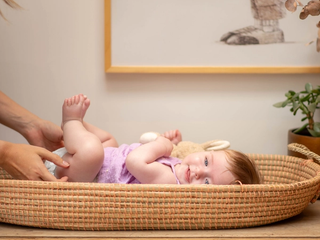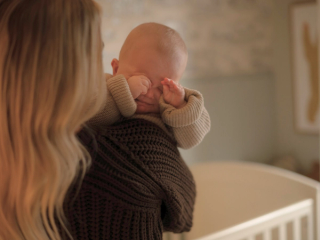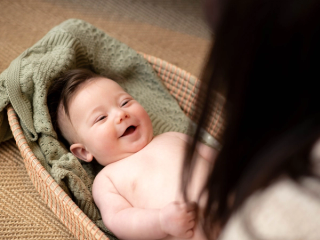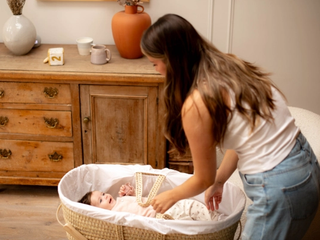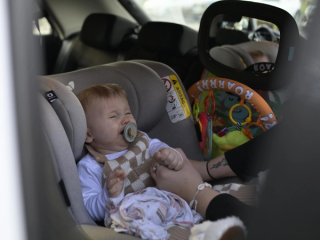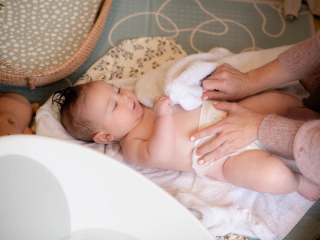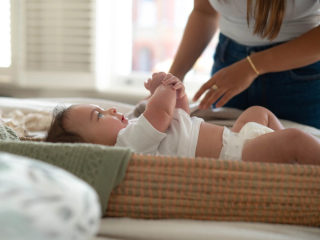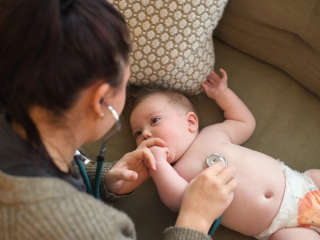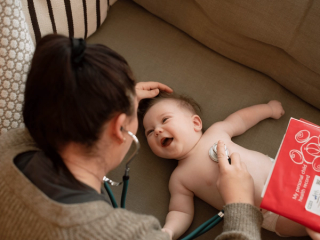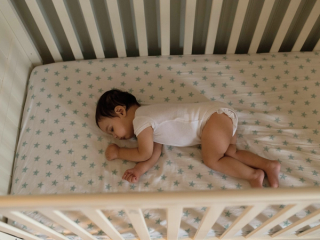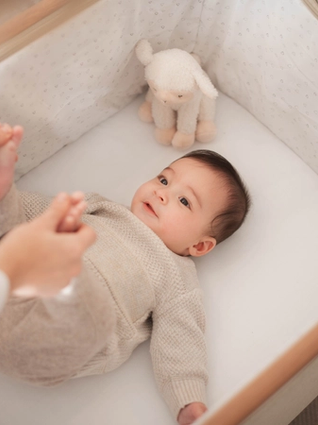
- Home
- Advice Hub
- Newborn
- Essential Newborn Care
- Baby Massage Tips: How To Massage Your Baby
Baby massage: a guide for parents
Baby massage is a gentle, calming way to bond with your little one. Discover tips to make this soothing activity a special experience for both of you.
Baby massage is a wonderful way to bond with your baby and provides many physical benefits alongside the soothing sensation of skin-to-skin contact. Whether you incorporate it into your bath or bedtime routine, add elements to nappy changes, or just take an ad hoc approach to baby massage, both you and your baby can benefit from the fun, calm and connection it brings.
In this guide, we’ll be laying out what baby massage is and when to use it, plus offering up a few tips for different massage strokes you can try.
What is baby massage?
Baby massage – much like any massage – is the process of using physical touch to soothe and stimulate your little one’s body. Unlike adult massage – which can be brutal! – baby massage is very gentle, and you do it with just your hands; no other tools are required.
Baby massage is a very natural act that almost mirrors the way, in nature, animal mothers will lick and groom their babies. It has long been part of parenting in Eastern cultures and has grown in popularity in the West more recently with the rise of baby massage classes, which help give parents confidence in the movements that will best suit their babies.
Benefits of massaging your baby
Baby massage is thought to improve the wellbeing of both parent and child, with some studies finding improved maternal mood and improved attachment, as well as linking baby massage with weight gain in pre-term babies. More generally, it also offers an opportunity to hydrate your baby’s skin – using appropriate massage oil or lotion – and can be used to soothe stomach complaints such as wind, helping your baby sleep more comfortably.
While the scientific evidence at this point is fairly thin on the ground, there are no disadvantages to baby massage, so it’s worth giving it a go. Any activity where you are face to face and skin to skin with your baby is an opportunity for bonding that will support their development and attachment.
When to begin baby massage
There’s no hard and fast rule about when to start baby massage, but classes typically aren’t offered for babies under 6 weeks. (This is probably partly because getting anywhere on time with your baby in the first 6 weeks is tricky!) At home, you can try some of the most basic techniques earlier than that – but be led by your baby. If they’re not enjoying it, they might not be quite ready for it yet. This isn’t a sign to give up – just hit pause for a few weeks while they get used to life in the outside world and all the stimulus it brings.
How to prepare for a baby massage
Babies don’t need a treatment room, candles and special scents – you really can massage them anywhere! Some of the most common times to try baby massage are before or after a bath, at bedtime, or with nappy changes. You can experiment and see what and when works for you, taking into consideration things like the room temperature, baby’s temperament (some babies loathe nappy changes and won’t be relaxed enough to try a massage at this point) and what is next in your schedule. Infant massage tends to be quite relaxing, so it’s good to capitalise on that by including it as part of a pre-bedtime or pre-nap routine.
In terms of the space you’re using, a changing mat, towel or blanket on the floor or on your bed will give you plenty of space to work with your baby. A changing table might be a little too small to give you the manoeuvrability you need. You can also try a few of the massage techniques with your baby on your lap. Just make sure you’re comfortable and that the space you’re in is safe, with nothing for either of you to bump into.
Low light is more relaxing than harsh overhead light, especially if you’re trying to get your little one into sleep mode. It’s also important to make sure they are warm enough as they’ll need to be mostly naked to enjoy all the benefits of baby massage.
A simple baby massage routine
If you attend baby massage classes or watch some videos online, you’ll see the most common baby massage techniques. This simple baby massage routine incorporates all of those – but the order is flexible, so again, experiment and see what your little one likes best and what makes sense for you.
Create a calm space
Baby massage is only relaxing if you and your little one are relatively relaxed. It’s not a technique we’d recommend trying while they are distressed or when you’re feeling frazzled. Try to carve out a good 15 minutes in your day to make the most of this time together. We recommend doing it fresh out of the bath (if the room is plenty warm enough and they’re not chilly) so that they’re already naked. This is a good time to hydrate their skin in any case. Lay a warm towel over a changing mat so there’s a nice, comfy surface to work on. If they seem a bit cold, you could also lay a warm towel over the top of them (not near their face) and move it around as you need to.
You might like to play some relaxing music in the background, or you could sing to your baby. They always love hearing your voice. It’s good practice to talk to your baby throughout the massage anyway, telling them what you are doing and generally checking in with them to make sure they are happy.
Start with gentle strokes on the legs
Babies’ legs are less sensitive than other parts of their bodies, so it makes sense to start here. Using oil or lotion and making sure your hands are warm, start by gently holding one ankle in your hand and use the other hand to encircle the top of their leg (as much as those chubby thighs will allow!) and very gently squeeze as you move your hand down towards their feet. Always move from the abdomen down (or out if you’re working on their arms). Once you’ve done a few strokes on one leg, switch to the other leg, then take both feet in your hands and gently press your thumbs into the soles of their feet and up to their toes. If you’re creating a routine that you want your baby to grow familiar with, you could aim to keep the time spent on each area consistent – say, 4 – 8 sweeps of each leg and foot.
Move to the tummy with light circles
Next, move to their tummy. Your little one doesn’t have to be totally naked to enjoy a massage but, if they’re wearing a nappy, consider loosening it at this point so you can better access the whole of their abdomen. Now, place the heel of your hands on the lower part of their tummy and gently smooth your hands, one after the other, across your little one’s skin in a fan shape. Always move your hand in a clockwise motion to aid digestion. The aim is to get as continuous a motion as possible. As a guide, you could aim for eight fans before moving on to the next step.
Massage the chest and shoulders
Your baby won’t have nearly as much tension in their shoulders as you do, so this is a very light press and release, simultaneously working both sides, starting with the heel of your hands at their sternum and sweeping outwards across their shoulders. Remember that babies’ chests are sensitive; keep it very light touch and do just four or so of these before moving on.
Focus on arms and hands
You can treat arms the same as legs, so hold your little one’s hand in one hand and use the other hand to gently smooth down their arm, either with a flat stroke or by holding their arm in the circle of your fingers. On their hands, rub small circles on their palms and press up their fingers from the base to the tip. And of course, you can also play ‘round and round the garden’ and get a lovely giggle!
Soothe the back with long strokes
Back massages can be done either lying down on their tummy or by lifting your baby up to your shoulder and running your hands down their back. If they are on their tummies, you can prop your little one on your legs and remember to be very gentle as you smooth your hands from their neck down to their bottom. Not all babies like being on their tummy, so play this one by ear and see how they get on.
Finish with a gentle face massage
Using your thumbs, start from the centre of the forehead and gently press outwards across your baby’s eyebrows. You can repeat the motion across the cheekbones and then softly trace your baby’s jaw before ending with a little boop on their nose. Ah, peace and tranquillity.
Best oils and products to use
Using oil or lotion will ease friction and make the massage more comfortable for your baby. If they are suffering from dry skin, this is also a good time to hydrate in a soothing manner. The NHS recommends not using any oils or lotions on your baby until they are 1 month old, but if you’re concerned about their skin before this age, consult your healthcare professional.
Avoid fragranced oils or lotions and try to stick with natural substances rather than synthetics. Things like almond oil and vegetable oils are good for baby massage as they are very neutral. Avoid olive oil, which can be hard on delicate skin, and potential allergens like peanut oil. It’s always best to do a little patch test on your baby before you slather their whole body in a new oil to make sure they don’t have a reaction.
Baby massage safety guidelines
Massaging infants is not like massaging adults – the number one rule is to keep the touch light and gentle. You should, as always, be led by your baby’s cues and if they aren’t enjoying it, stop and try again another day. You want them to associate your touch with love and calm and pleasure, not discomfort.
As mentioned, it’s important to give yourself plenty of space for the massage and give them something soft to lie on so that they’re comfortable and happy. Also, as discussed, avoid using oils that are hard on their sensitive skin. If in doubt, you could ask your health visitor for advice.
Making baby massage a special time
Baby massage can be such a lovely part of your routine. It provides a unique opportunity for loving touch, skin to skin contact, eye contact and time to chat to and sing to your baby – more so even than bath time since you are face to face rather than side by side. Make the most of this time by not rushing through it. It’s also a good idea for both parents to get familiar with baby massage so both can share that special bond with your baby.
If we haven’t said it enough, listen to your baby’s cues and bring the massage to a close if they aren’t enjoying it. If they are enjoying it, there’s no time limit – so long as they’re warm and comfortable and happy, you can keep going!
Frequently asked questions about baby massage
You can follow all the above techniques with a 2-week old baby, but you should consider that baby massage is quite a lot of sensory stimulation and so for brand new babies it’s best to keep it brief. Rather than following the whole routine from start to finish, you could incorporate little bits of it into your day, such as a leg massage after a nappy change, or a gentle hand massage while you’re giving them a cuddle. If your 2-week old doesn’t enjoy massage, don’t worry. You can always try again when they’re a little bit older.
There’s no standard answer to this – the answer is very much: how long do you want to wait? While also taking into account the nature of the birth. For example, if the birth was straightforward and you are not opposed to the idea of people touching you (being ‘touched out’ is a very common side effect of being a mother), there’s nothing to stop you having a lovely relaxing massage. Remember, this could be a foot massage, head massage, neck and shoulder massage – no one has to go anywhere near your stomach or intimate parts to help relax your aching muscles. If you had any difficulties during childbirth or if you have specific pain you want relieved, it’s of course best to consult your health professional before seeking a post-natal massage.
The scientific evidence for the benefits of baby massage is not very comprehensive. It’s generally agreed that it benefits the bond between baby and mother and many babies seem to enjoy it, but there’s no proof of measurable outcomes for term babies, such as weight, growth, sleep duration, etc. However, it has been shown to be beneficial for pre-term babies’ weight gain – which is an encouraging sign. The general consensus is that baby massage (when done properly) is certainly not going to do any harm and if everyone enjoys it, that is a benefit. Strengthening the bond between parent and child will help your baby feel safe, loved and nurtured, which is an excellent foundation for their future happiness!
